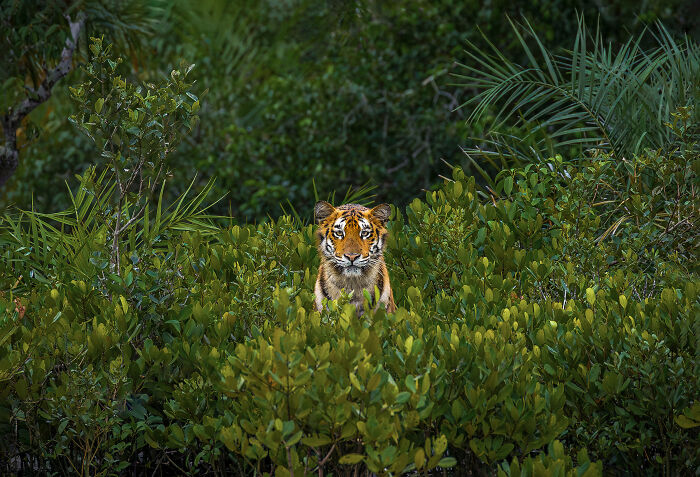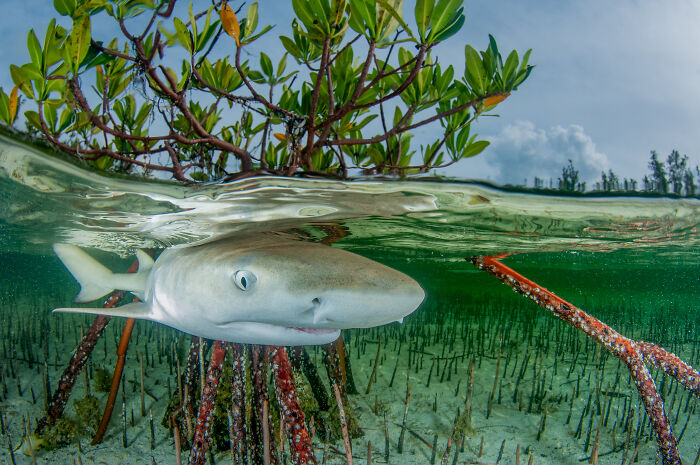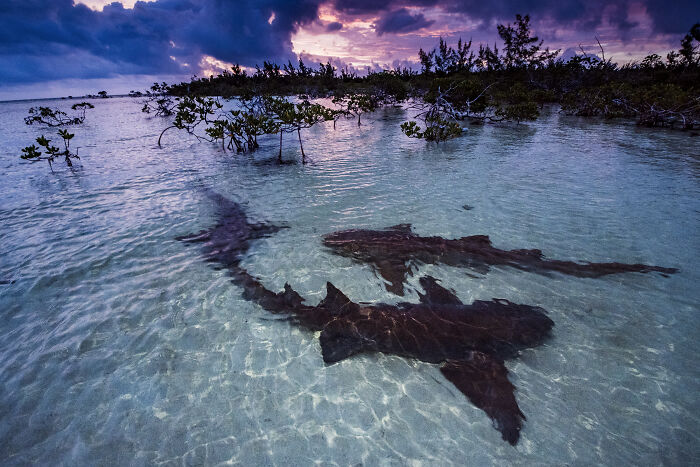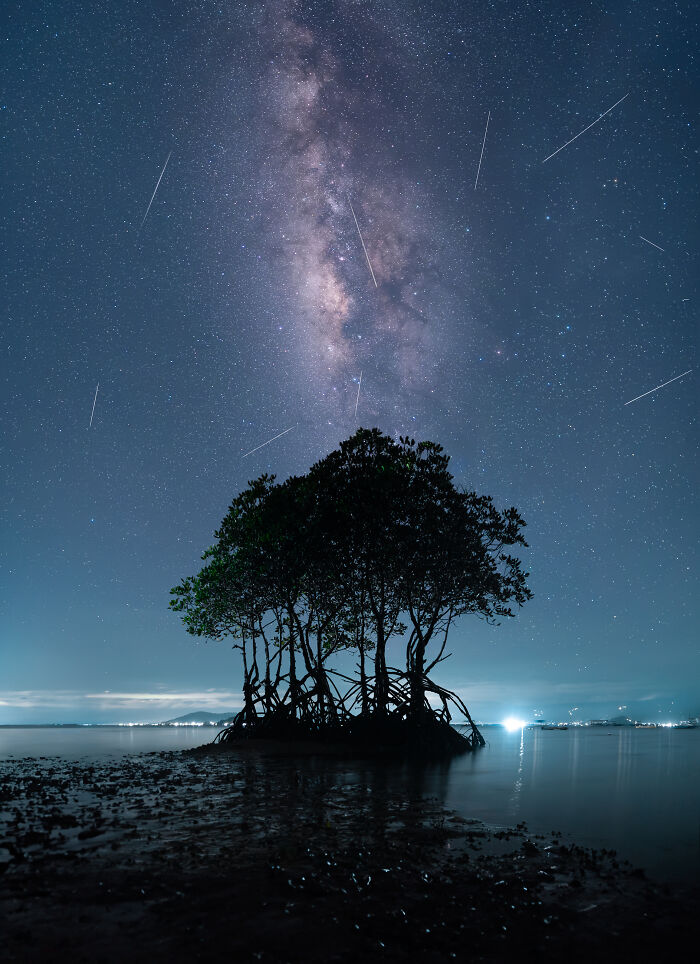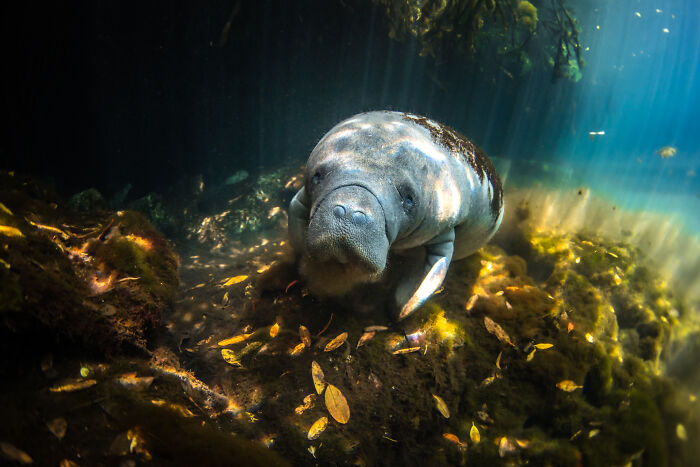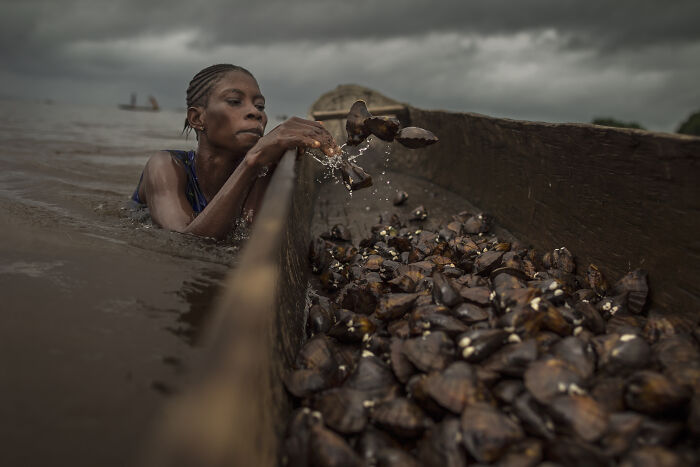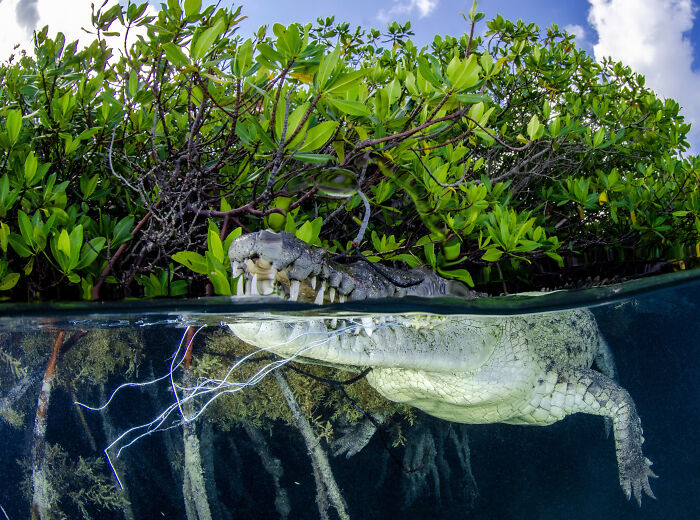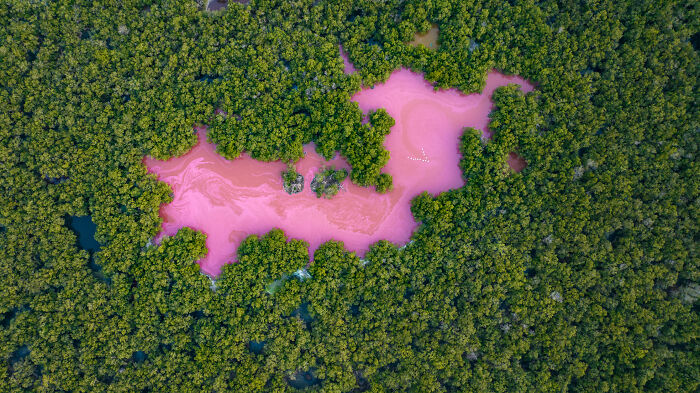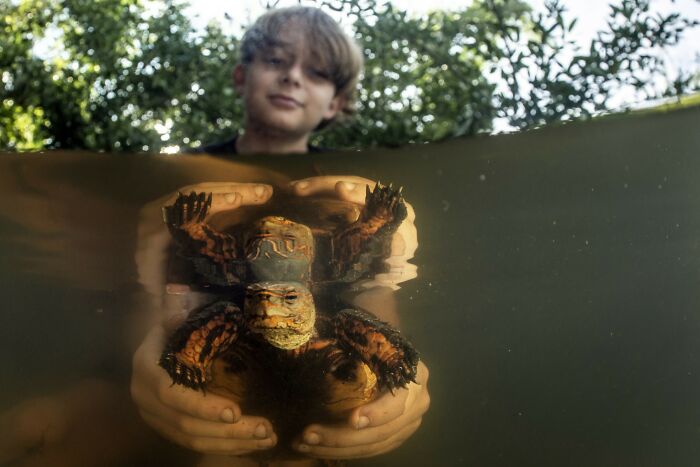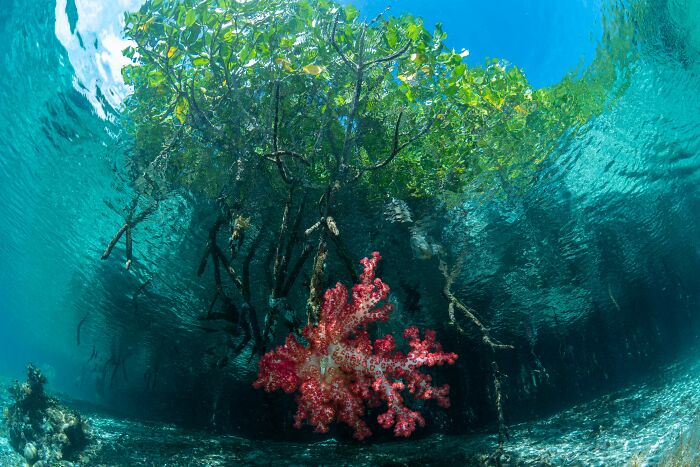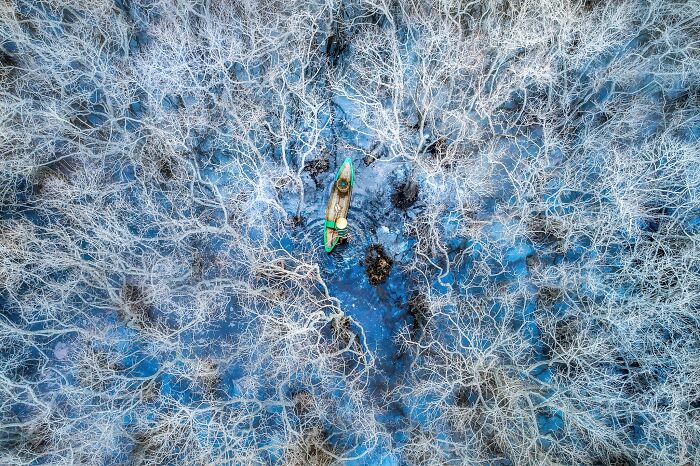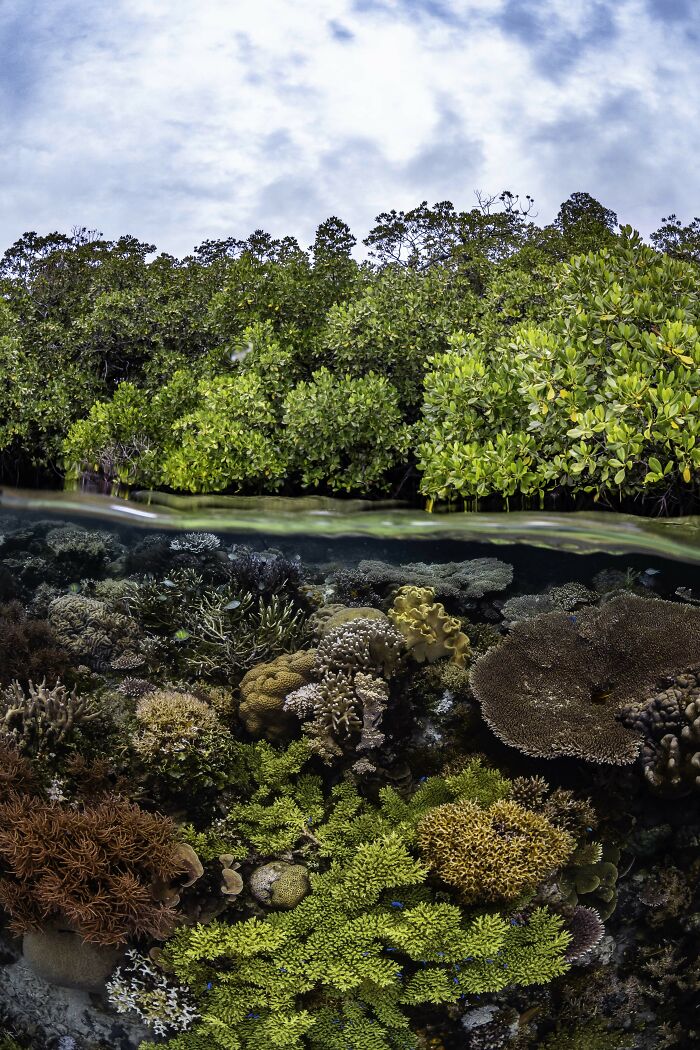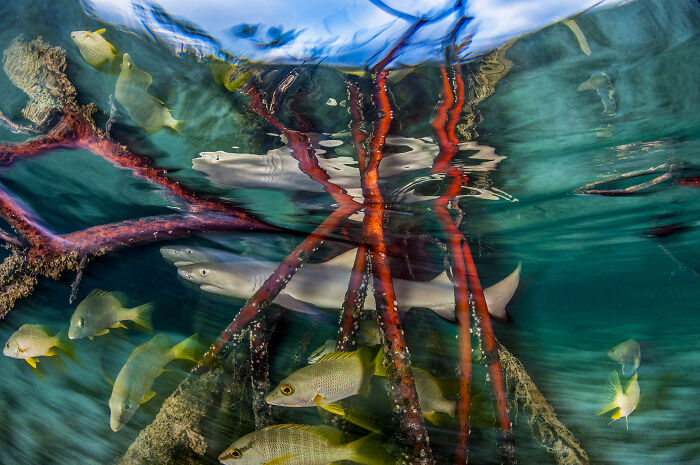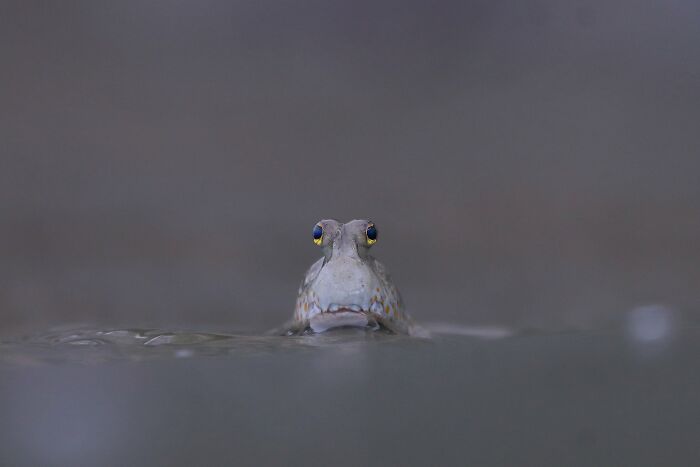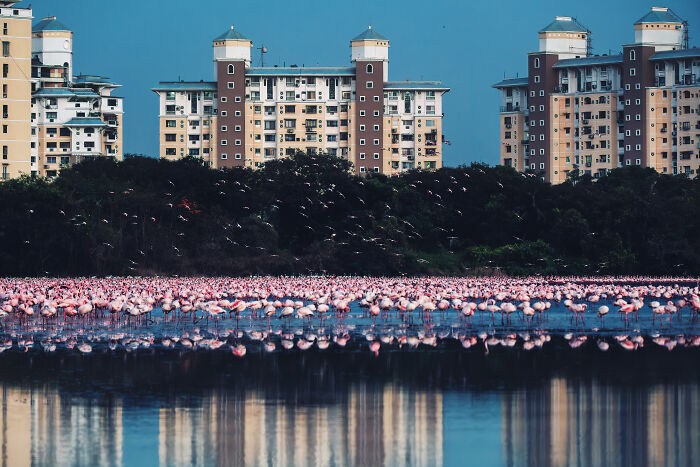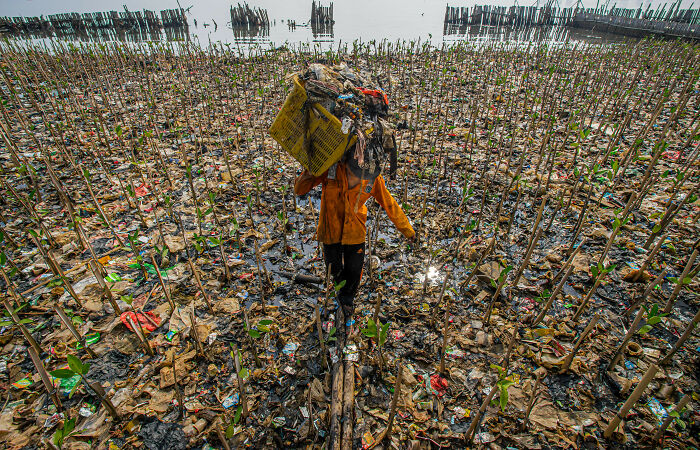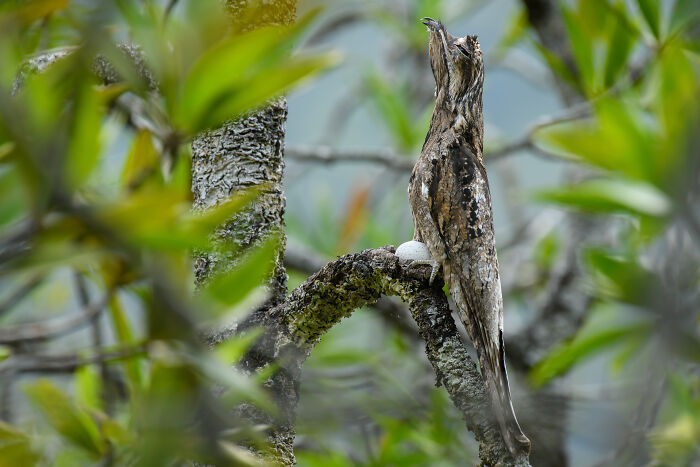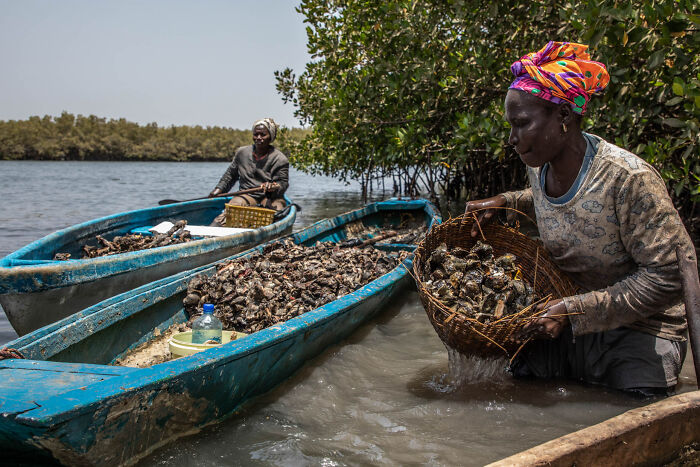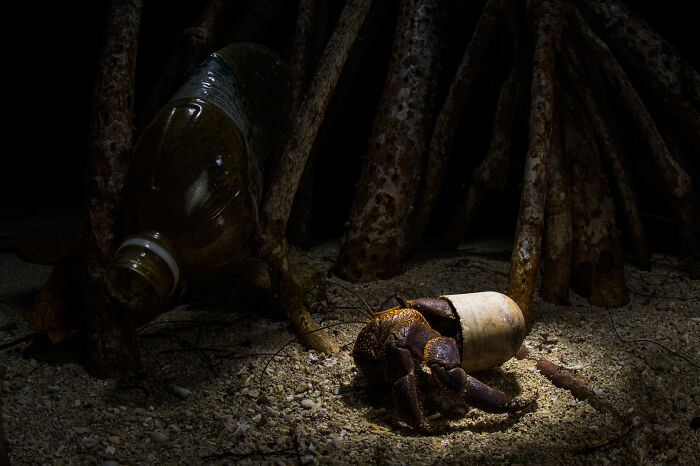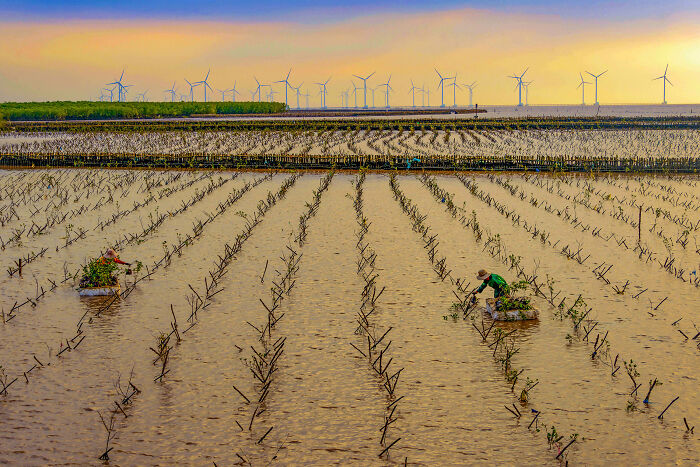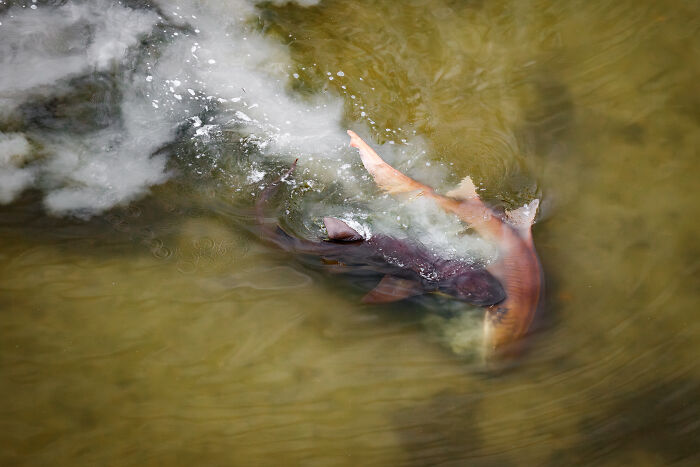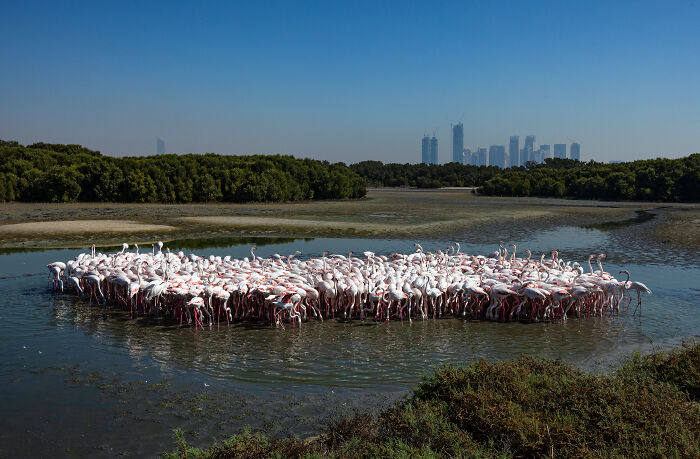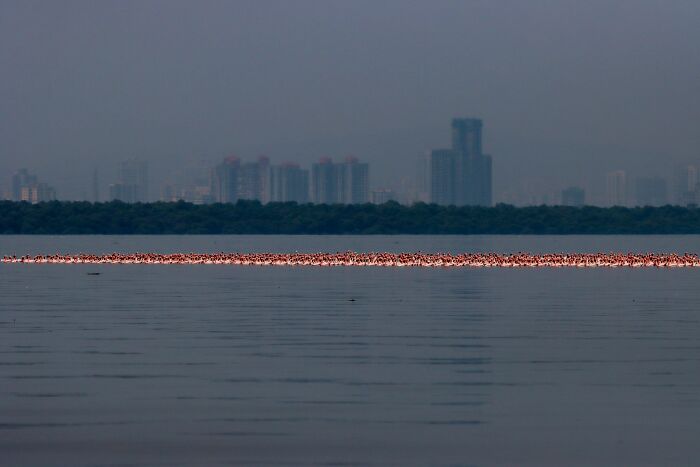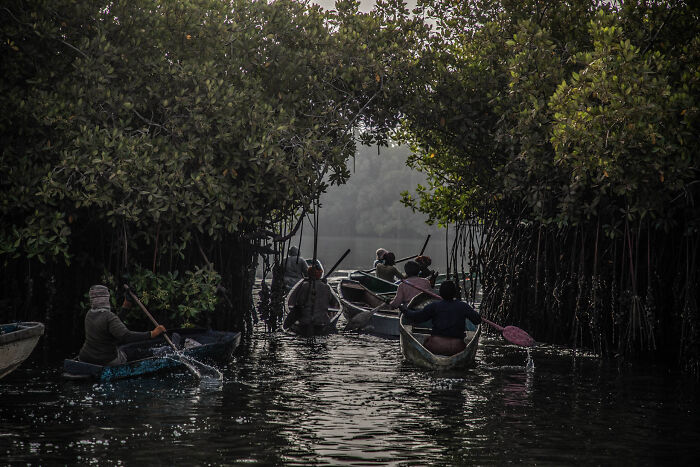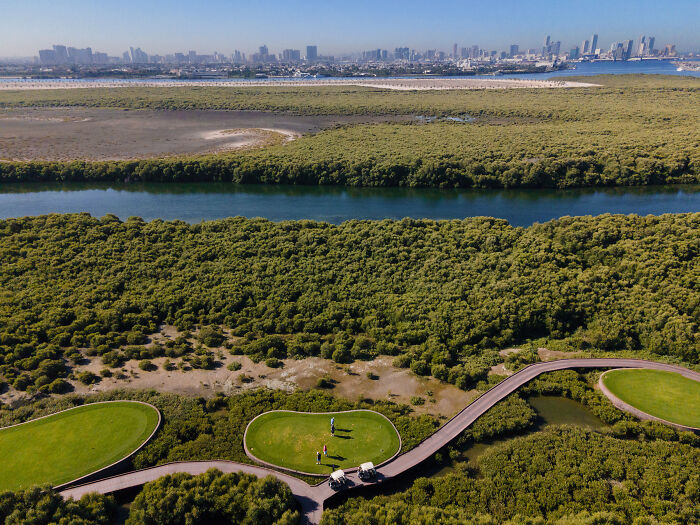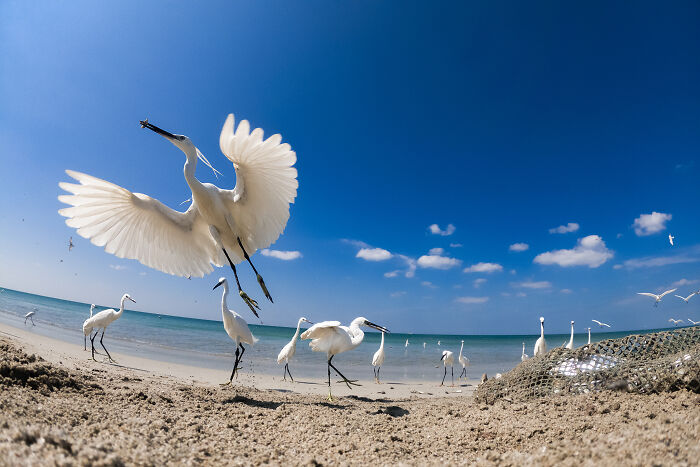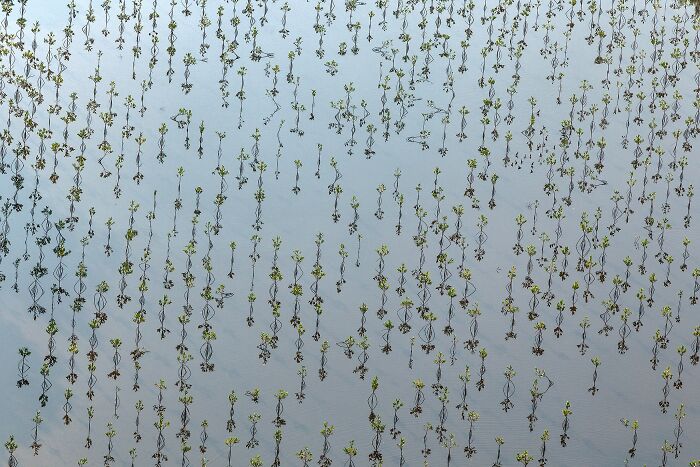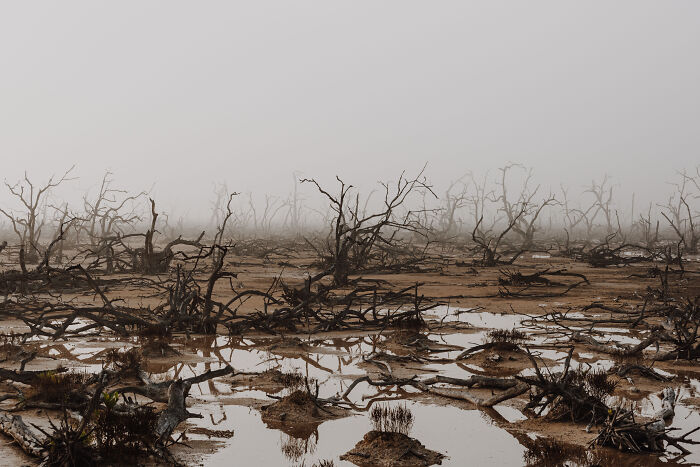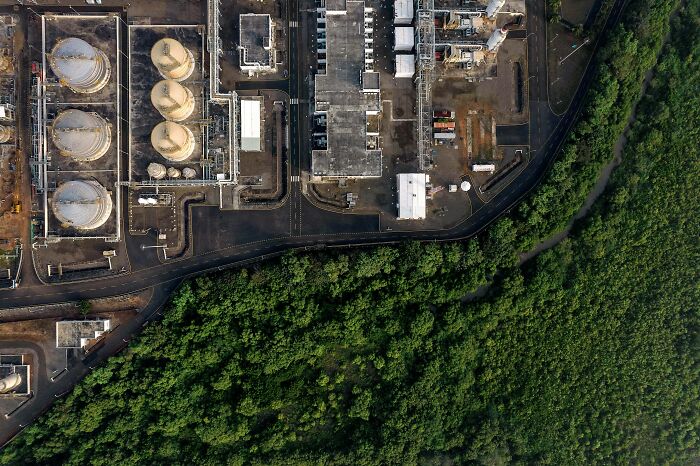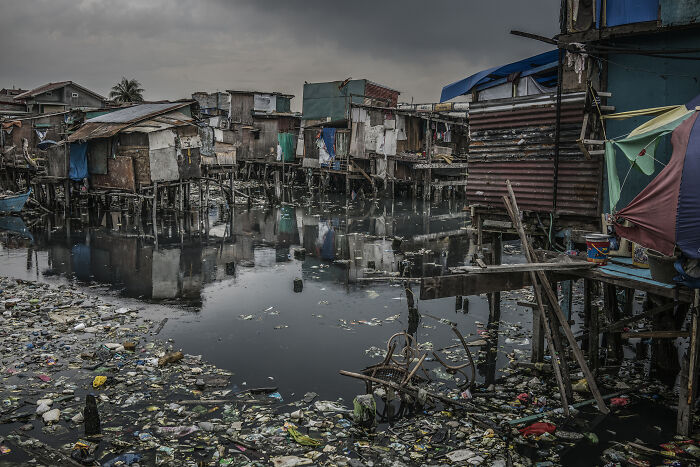After weeks of deliberation, the Mangrove Action Project announced the winners of the 9th Mangrove Photography Awards.
As we read on the MAP website: "Year after year, creatives continue to inspire us with their incredible shots that help raise awareness of the people and wildlife that rely on mangrove forests, the threats these ecosystems face, and why urgent action is needed to protect them. This year’s awards has been one of the most diverse yet, with over 2,000 entries from 72 nations around the world, showcasing the beauty and global significance of mangrove ecosystems."
More info: photography.mangroveactionproject.org | Instagram | Facebook | Instagram
This post may include affiliate links.
Overall Winner: The Finest “Flower” Of The Mangroves By Soham Bhattacharyya, India
Soham Bhattacharyya / Mangrove Photography Awards
‘The Finest “Flower” of the Mangroves’ captures a heart-warming image of a young Royal Bengal tigress through the mangrove bushes of a fragile natural wonder.
“The solitary figure of the tiger, standing amidst the lush green mangrove forest vegetation, poignantly underscores the isolation it must endure in an ever-shrinking habitat”, said judge Daisy Gilardini.
There are perhaps only 200 of these magnificent animals in the Sundarbans mangrove forest. According to the last survey conducted in 2018, there were 114 tigers in the Bangladesh portion of the Sundarbans. West Bengal Forest Department recent tiger estimation exercise for 2020-21, puts the number of big cats in the region at 96. These iconic and endangered Bengals are the only tigers adapted to live in a mangrove habitat.
Sadly, the largest mangrove forest in the world is also under threat, with nearly a staggering 25 percent lost (136.77 square km) due to erosion and human pressures over the past three decades.
In addition to the Mangrove Photographer of the Year, winners have been selected in 6 categories – People, Landscape, Underwater, Threats, Wildlife, and Stories (a portfolio category) – while photographers under the age of 24 competed to become the Young Mangrove Photographer of the Year.
"The photos are a compelling reminder of the importance of mangroves for the diversity of life across our coastlines as photographers captured unique relationships and moments from mangrove ecosystems both above and below the water line. They’re also a stark reminder of our need to protect these unique and precious ecosystems.
Today, less than half the world’s original mangrove forest cover remains, and it has never been more important to promote the conservation of these fragile ecosystems. The Mangrove Photography Awards is a vital platform for creatives to captivate our imagination and spark action."
Feel free to check out our previous post to view the list of the winning photographs from 2022.
Mangroves & Underwater Winner: A Lemon’s Life By Anita Kainrath, Bahamas
A juvenile lemon shark swims in shallow mangrove forests in the Bahamas. Lemon sharks are probably the most understood sharks in the world, thanks to over 30 years of studies by Bimini Shark Lab.
“Lemon sharks spend their first 4-6 years in shallow waters where mangrove forests protect them from bigger predators. They build friendships with other juvenile sharks and learn how to hunt. They are absolutely gorgeous, smart, curious and clumsy. Mangroves build a perfect ecosystem and are their nursery and for so many other species.”
The sharks also use natal philopatry, meaning when mature (12 - 14 years old) females are ready to pup, they return to the same mangrove nursery that they were born in and drop their own pups there.
Mangroves & Landscape, Highly Commended: Courtship By Shane Gross, The Bahamas
Nurse sharks gather in the peaceful Bahamian mangroves to mate. “I was sleeping in my tent on an adjacent beach when I heard splashing before sunrise. I grabbed my camera and ran out to see nurse sharks mating in knee-deep water.”
Mangrove forests serve as crucial nursery habitats for lemon sharks during their early life stages. Juvenile lemon sharks, as well as other marine species, find shelter and protection among the submerged prop roots and dense vegetation of mangroves. Mangrove ecosystems are highly productive and provide an abundant food supply for lemon shark pups. These habitats are rich in organic matter and support the growth of small prey species, such as fish and crustaceans.
Bored Panda reached out to Leo Thom, the Creative Director of the Mangrove Action Project, organizing the annual photo awards. We asked him some questions about the contest, and he was kind enough to share with us some valuable insights.
This year, the Mangrove Photography Awards received over 2,000 entries. We were wondering what Thom believes is the driving force behind such a strong interest in mangrove conservation through photography. Leo told us: “Our photography contest has been growing every year and I think there's a great appetite right now to photograph and tell intriguing stories about the environment in general so that it can inspire people to take positive action. Mangroves are fascinating and unique ecosystems that are still seen as the underdogs of forest habitats so we are so thrilled that so many photographers all over the globe have been getting dirty in the mud, taking photos and sharing their beautiful images on our platform.”
Mangroves & Landscape, Highly Commended: Between Ancient And Modern Lights By Aaron Ruy G. Musa, Philippines
Lights from the city, milky way and Lyrid meteor shower emanate in alignment out of the mangroves trees during darkness and low tide.
“Fortunately, I was able to capture several meteors around the galaxy core despite the light pollution emanating from Bais City in the background and the uncluttered foreground on the left side of the image.”
Mangroves & Underwater, Highly Commended: Face-To-Face By Valentina Cucchiara, Mexico
A young manatee feeds at the bottom of a shallow lagoon in Mexico. Boat traffic, deforestation, and pollution all threaten manatees and their habitats. Manatees are drawn to mangroves as the trees grow tightly together, creating small open passageways over the water that provide safe underwater shelter for manatees to rest, raise young, and find food.
“I have enjoyed getting to know this juvenile manatee over the past year, and he is a curious one...I always descend away from him when he's feeding and wait to see if he approaches me. At times, I am the one who needs to move now as he won't budge!”
Asked if there were any particularly surprising or unexpected aspects of this year's submissions that caught his attention, Leo answered: “Mangroves still surprise me every day even though I've worked with them for a while now. Some people may not know about the Sundarbans, which is the largest mangrove forest in the world and home to the only tigers that have adapted to live in these dynamic swamps. I've enjoyed seeing new wildlife behavior this year from the mating nurse sharks and the potoo bird blending in perfectly into its surroundings to the poignant image of the hermit crab living in a microplastic world.”
Mangroves & People Winner: Séphora The Clam Diver By Kris Pannecoucke, Democratic Republic Of The Congo
Between river, sea and land, the Mangrove Marine Park, a fragile nature reserve in Bas-Congo, is the kingdom of turtles, manatees and women who harvest clams.
“The Mangrove Marine Park is a veritable maze of islands and channels. Women like Séphora dive up to four metres for clams. They sell skewers with clam meat in the cities of Muanda and Boma. Entire islands, like Kimwabi where Séphora lives, are built on empty shells.”
Since the dawn of time, people have been diving in the mangroves in search of clams. At a depth of four meters, she carefully scans the ground with her hands until she finds clams. She grabs a handful and emerges, throws them into her canoe and disappears into the water again. She spends hours in the Congo River until her canoe is full or the tide comes in and her treasure disappears into inaccessible depths. The current is treacherous, in the Congo estuary it is so strong that sediments are carried up to 800 kilometers into the Atlantic Ocean. Séphora and dozens of other women dive for clams in the Parc Marin des Mangroves, a fragile nature reserve.
Mangroves & Threats, Highly Commended: Wild & Free By Yordanis Méndez Segura, Cuba
In the Gulf of Ana María, this mangrove-dwelling American saltwater crocodile was spotted with its mouth tangled in nylon rope.
Next, we were curious about what advice or tips Thom could provide to enhance the chances of success for individuals interested in participating in future Mangrove Photography Awards. The Creative Director shared with us: “I think my top tip would be to be curious. The ultimate goal is to intrigue people about the ecosystem and by spending more time in the mangroves yourself, you will start to see and find out new things you didn't know before. I think through observation you will start to see what is interesting; whether it's a special relationship local people have with their forests or a particular animal that is visiting the mangroves. Winning photos don't need to be technically amazing; it's more important that the image is telling a story for the viewer.“
Mangroves & Landscape Runner Up: Pink Mangrove Lagoon By Felipe Santander, Colombia
Unique conditions in temperature, minerals, and algae turn this lagoon in Colombia pink. Photographer Felipe Santander spent four days and 15 drone batteries to capture the perfect shot, complete with the formation of birds flying over the pink lake. The salinity of the seawater combined with rising temperatures makes for an ideal situation where the microscopic pink algae can thrive. This is likely to become more common with rising temperatures due to climate change.
“In the least expected area of a mangrove in the Caribbean coast of Colombia, near Cartagena, a pink lagoon forms seasonally, given unique conditions of water ph, temperature, bird presence, and light – a magical and unexpected sight.”
Mangroves & People, Highly Commented: Hope By Sergio Izquierdo, Guatemala
Teaching future generations to preserve mangrove ecosystems.
“After ecocide by the palm industry, flooding the biggest mangrove reserve in Central America, Manchon Guamuchal (Guatemala), with chemicals, a group of NGOs and environmentalists carried out the largest animal liberation in Guatemala, where more than 300 animals were released into the wild.”
Lastly, knowing that mangroves are currently facing numerous threats, we wanted Leo to tell us more about some of the most pressing issues that these ecosystems are dealing with and how the awards contribute to addressing these challenges. Thom said: “Yes, mangroves are facing all sorts of threats around the world and it's never been so important to conserve and protect existing areas of healthy and biodiverse forest. You can see from this year's images that plastic is a huge problem on our coastlines, something we can all consider when making choices in our day-to-day lives. The aim of the Mangrove Photography Awards is to spark empathy and connection to our natural world, which ultimately leads to a conservation impact on the ground. It gives people an opportunity to raise their voices for the protection of one of the most critical and threatened ecosystems.”
Mangroves & Underwater, Highly Commended: Attachment By Puttarat Horwang, Indonesia
Colorful, soft coral grows on the roots of mangroves in the crystal-clear waters of Bluewater in Raja Ampat.
“While most areas around mangroves tend to have turbid water, this location stands out. Positioned in the middle of the ocean, the soil particles that typically cloud the water are swept away by the tide, rendering the water in that area clear. The currents allow soft corals to coexist with the roots of the mangrove trees.
Mangroves & People Runner Up: In The Forest By Phan Thi Khanh, Vietnam
A fisherman navigates the winter mangroves in Hue, Vietnam. Ru Cha Mangroves Forest is nestled in Tam Giang Lagoon in Thua Thien-Hue Province. In the local dialect, ru means forest while cha is the name of the trees growing densely in the forest.
“Ru Cha is a mangrove forest that is considered the green lung of Tam Giang lagoon. Each season, the scenery in Ru Cha has its own beauty. In winter, the mangrove trees shed its leaves, leaving thin white trunks. Seeing that scene is like a giant spider web.”
Mangroves & Underwater Runner Up: Forest Meets Reef By Brooke Pyke, Indonesia
A lush and thriving mangrove forest grows atop a vibrant coral reef in Raja Ampat's Gam island – a split shot depicting two ecosystems that are vital for the health of our oceans.
“Quietly swimming on the surface, trying not to disturb the water, I snapped this photograph using a strobe to light the corals at the bottom and ambient light for the trees above.”
Connectivity between mangroves and coral reefs is a critical ecological relationship that plays a significant role in the health and sustainability of these ecosystems. The Indo-Pacific region is known for its extensive mangrove forests, with Indonesia alone comprising one fifth of the global total. Mangroves often fringe coral reef coastline and the connectivity between mangroves and corals is of critical ecological importance. Mangroves provide many benefits to coral reefs including protection from sedimentation, filtering nutrients from land and rivers, and a nursery habitat for many species of juvenile fish.
Mangroves & Underwater, Highly Commended: Nursery By Shane Gross, Bahamas
Lemon shark pups hide in the mangroves at high tide.
“Baby lemon sharks use the tangle of roots from mangroves to hide from larger sharks during high tide. At low tide, when the water is too shallow for large sharks, they will head out onto the flats to feed. I have spent hundreds of hours with these baby lemon sharks and know many of them individually.”
Young Mangrove Photographer Of The Year Winner: Eye Contact By Katanyou Wuttichaitanakorn, Thailand
A baby Golden-spotted Mudskipper snapped on the edge of a mangrove in Samut Sakorn province, Thailand.
Mudskippers are an amphibious fish and can use their pectoral fins to "walk" on land.
Mangroves & Threats, Highly Commended: The Window View - A Coexistence By Sreekumar Krishnan, India
An apartment complex faces the Talawe Lake, an inter-tidal part of the mangrove system. The flamingos visit annually and find comfort from the high tide of the shore line. More of these lakes are being lost to developments.
“Apartment citizens are fighting tooth and nail to protect the lakes and mangroves from being encroached. This beauty needs to be protected and to show the world that humans can coexist if space is allowed.”
Mangroves & Threats Runner Up: Cleaning Up The Coastline By Gerdie Hutomo, Indonesia
A worker carries a crate full of garbage from the North Coastline of the city of Jakarta, Indonesia. “All of the garbage came from the river inside the city and flowed north to the coastline and piled up massively, disturbing the growth of the mangrove trees.”
Plastic debris, such as bottles, bags, and microplastics, can accumulate in mangrove forests. This physical contamination can smother and damage mangrove roots, which are essential for stabilizing the coastline and providing habitat for numerous species.
Plastics can obstruct the flow of water within and around mangrove habitats. This obstruction can disrupt natural hydrological processes that are vital for maintaining the health of mangroves and the organisms they support
Plastics can leach harmful chemicals into the surrounding soil and water as they break down. These chemicals can negatively impact mangrove ecosystems by affecting water quality, soil health, and the health of the organisms living in and around mangroves.
Mangroves & Wildlife Winner: Hiding In Plain Sight By Chien Lee, Colombia
In the mangrove forest of Colombia’s Utría National Park, a Common Potoo (Nyctibius griseus) is nearly indistinguishable from the surrounding branches while it perches motionless on its nest.
“As I didn’t want to risk disturbing the Potoo into flight, I photographed it with a long telephoto lens some distance away and partially obscured by the branches of intervening mangrove trees. It was only after looking through the lens that I realized there was actually a single egg.”
Utría National Park, located on Colombia's Pacific coast in the Chocó region, is renowned for its stunning biodiversity. One of the highlights of the national park is the potoo, a fascinating and cryptic nocturnal bird. One striking feature of the potoo is its remarkable camouflage. During the day, it perches on tree branches, remaining perfectly still, with its cryptic plumage resembling a broken tree branch or stump. This camouflage helps it blend seamlessly with its surroundings, making it exceptionally challenging to spot.
Mangroves & Conservation Stories Runner Up: Stewards Of The Mangroves By Jason Florio, Gambia
The River Gambia's mangroves are crucial to its ecosystem, and benefit the local women who collect oysters. The wetlands are an important carbon sink, storing up to 10 times more carbon than forests. The TRY Oyster Women Association plays a vital role in protecting the wetlands, educating members to preserve the mangroves and harvest sustainably, as well as engaging in reforestation, planting 50,000+ mangrove seedlings - encouraging the women to consider themselves stewards of the mangroves.
Mangroves & Threats Winner: The Theatre Of Plastic By Emanuele Biggi, Malaysia
A land hermit crab wanders around at night, close to the beach of Pom Pom island, Sabah, using a plastic deodorant plug instead of a shell.
“Pom Pom island is a violated paradise, where the small island and its coral reef are continuously raped by tons of plastic material coming from nearby Bornean shores, especially from Semporna city. When I found this poor hermit crab… I knew I found my sad ambassador for this terrible human problem.”
Hermit crabs rely on empty shells for shelter and protection. Plastic debris, including bottle caps and other discarded items, can sometimes resemble shells. Hermit crabs may attempt to inhabit these unnatural "shells," which do not provide the necessary protection and can hinder their growth and survival.
Marine animals often mistake plastic debris for food. This can lead to ingestion, which can cause internal injuries, blockages, and malnutrition. Discarded fishing nets, lines, and other plastic debris can entangle and trap marine animals, leading to injury, drowning, or suffocation. Seabirds, seals, sea lions, and sea turtles are common victims of entanglement.
Mangroves & People, Highly Commented: Planting Mangrove Forests By Kim Cuong Nguyen Trang, Vietnam
Mangrove planting takes place in this forest of Vietnam.
“This place has a rich and preserved flora and fauna ecosystem.”
Mangroves & Wildlife Runner Up: Mating Nurse Sharks By Mark Ian Cook, USA
Taken from a helicopter while conducting a scientific study of waterbirds, Mark captured the rarely observed mating behaviour of two large Nurse Sharks in the shallow waters off the mangrove-lined (and aptly named) Shark Point in the Everglades National Park, Florida.
“Sheltered mangrove habitats that are largely free of human disturbance are critical mating and nursery habitats for a number of shark species, and protecting these areas is essential to sustaining shark populations.”
The tangled prop roots and submerged vegetation offer a secure environment where adult sharks can engage in courtship without the disturbances and turbulence often found in open waters.
Mangroves & Wildlife, Highly Commended: Gathering By Shyjith Onden Cheriyath, Uae
The mangrove forest in Ras Al Khor serves as a crucial stopover and wintering ground for thousands of migrating flamingos. These elegant birds migrate to the sanctuary in large numbers during the winter months, seeking refuge from colder climates. Ras Al Khor provides them with an abundant source of food, including the shrimp and small fish found in its brackish waters. The sight of these graceful birds against the backdrop of Dubai's modern skyline is a stunning juxtaposition of nature and urbanity.
Mangroves & Wildlife, Highly Commended: The Water Is On Fire By Vidyasagar Hariharan, India
The Thane Creek Flamingo Sanctuary hosts one of the largest congregations of greater and lesser flamingos in the world. During peak migration months, it's not uncommon to see tens of thousands of flamingos gathered in the sanctuary. The sanctuary provides an ideal feeding ground for the flamingos, as it is rich in brine shrimp and other aquatic organisms, which are a staple of their diet.
“The dull water of the Thane creek looks like it's on fire with these pink pilgrims – a sight to behold.”
Mangroves & Conservation Stories Runner Up: Stewards Of The Mangroves By Jason Florio, Gambia
Mangroves & Landscape, Highly Commended: Surrounded By Nature By Shyjith Onden Cheriyath, Uae
Perhaps more appropriate in the “Threats” category, golfers can experience winding waterways, lush greenery and abundant wildlife of the mangroves while playing at this course.
“Nestled amidst the enchanting mangrove forests of the United Arab Emirates, Al Zohra Mangrove Golf offers a golfing experience unlike any other. As golfers step onto the course, they are greeted by a breathtaking landscape of winding waterways, lush greenery, and an abundance of wildlife.”
Mangroves & Wildlife, Highly Commended: To Theft Of Fish By Kaveesha Madhubhashana, Sri Lanka
Egrets stealing fish from nets in Mannar Island, Sri Lanka. “I took this shot near the mangrove lagoon. This egret caught the fish from the fish net and flew away. It's very interesting animal behavior to look at.”
Mangroves & Landscape, Highly Commended: Natural Design By Jorge Silva, Mexico
Natural or unnatural? The symmetry of planting mangroves in rows reveals itself from the air. “With the first light of day from an ultralight plane, the reflections in the water of the small mangrove seedlings, the product of reforestation work in La Encrucijada Biosphere Reserve, designed a beautiful landscape.”
La Encrucijada is also home to the tallest mangroves in Mexico, reaching a height of 20–35 m. The UNESCO MAB Programme in collaboration with CONANP has launched a project to conserve and restore mangroves in La Encrucijada Biosphere Reserve. The project is also encouraging natural regeneration to restore the mangroves and halt further mangrove loss.
UNESCO is working closely with local communities and local management committees in the participating biosphere reserves to restore their mangrove forests. Education will be a strong component of the project; young people will be involved in the project to support implementation within their own communities. The project will also strengthen grassroots networks as a means of raising awareness and developing skills to facilitate collective action.
Mangroves & Threats, Highly Commended: The Aftermath By Esteban Ernesto Dupinet Valencia, Mexico
Mangroves & Landscape, Highly Commended: Black Dawn By Mannepuri Srikanth, India
A drone image from Godavari mangrove forest in Andhra Pradesh, India shows
mangroves in proximity to a large industrial site.
“Hundreds of hectares of mangroves are cleared to make room for these industries. But that is not the end of the problem. These industries typically release effluents into the nearby ponds on several occasions. Sometimes these effluents create an impervious physical and toxic oily layer.”
Mangroves & Threats, Highly Commended:
What is the most heartbreaking is we don't even know if future generations will be able to see this beauty. So much development and misuse of land happening worldwide.
What is the most heartbreaking is we don't even know if future generations will be able to see this beauty. So much development and misuse of land happening worldwide.

 Dark Mode
Dark Mode  No fees, cancel anytime
No fees, cancel anytime 














